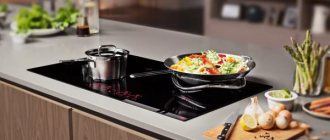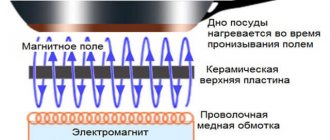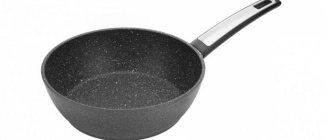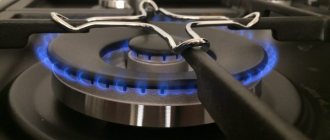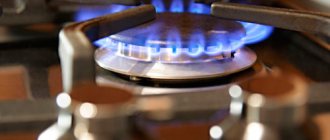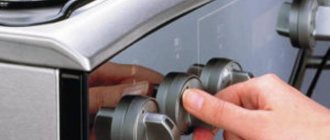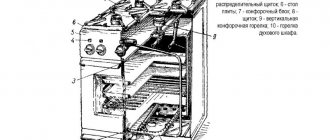Modern home appliance stores have a huge selection of stoves for every taste. However, buyers often wonder which stove to buy - gas or induction. Many people choose a gas appliance. It is more common to use, and gas is cheaper than electricity. However, if you start to understand this issue more deeply, the situation will no longer be so clear. In terms of convenience and quality of cooking, many people prefer induction devices.
Which stove is better - gas, electric or induction - we'll figure it out in the article.
How much gas does a gas stove consume?
This type of stove has 4 burners + 1 in the oven. Each of them has its own power, which according to GOST is measured in kW. All parameters of the burners are specified in the product passport and differ depending on the model and the country that produced it. The total power of the burners is 10 kW.
Gas is measured in cubic meters. m/hour. Find the sum of the powers of 4 burners + 1 in the oven, divide by the calorific value of the gas, which is 8–11 kW*hour/cubic meter. m.
For example, a device has 2 medium burners, 1 with a low burner and 1 with a high burner for gas consumption. After mathematical operations of gas consumption with a 4-burner stove, we get the result: (0.6 kW+2.6 kW+1.7*2 kW) / 8 kW*hour/cubic meter. m=1.2 cubic meters m/hour. This indicator should be indicated in the instructions for the stove.
If documentation is missing, take an average of 1.2 to 2.5 cubic meters. m/hour. When the stove operates for approximately 1 hour every day per month, the fuel consumption will be: 1.2 cubic meters. m/hour*30 hours=36 cubic meters m.
Reference. When calculating, it does not matter whether liquefied or natural gas is used.
The meter will calculate gas consumption as accurately as possible. The stove, unlike the column and other appliances that consume gas, consumes it to a minimum. To select a meter, contact specialists who will calculate the throughput of all installed gas appliances and select the desired type. If the meter is incorrectly selected, the gas fee will be much higher.
Guide to choosing an electric hob
Let’s immediately make a reservation that in this article we will talk about the nuances of choosing the latest generation hobs, and we will keep silent about outdated models with cast iron “pancakes”, if only because their profitability is deceptive due to high energy consumption and prolonged heating.
Which type of heating elements is best?
This selection criterion is one of the key ones. After all, the efficiency of the stove directly depends on the heating elements. So, there are only 3 of them:
- Spiral. They are equipped with the most inexpensive panels and, at the same time, the most inefficient. They used to be popular, but today they have given way to hi-light slabs. The heating time of the spiral burner is 8-12 seconds.
- Tape (Hi-light). Plates with tape heaters are the most popular. They are about twice as efficient as the previous ones and can heat up in 3-6 seconds.
- Halogen. These burners are very efficient and provide more uniform and almost instantaneous heating. They can compete with induction and gas stoves. Their only problem is the possibility of overheating due to prolonged cooking, and, of course, the high price.
What types of burners are there?
The burners of an electric hob are always of different diameters, and at least one of them is most often two- or three-circuit, that is, it can vary in size - from small to large. The presence of such a burner is especially important for a small domino-type hob (with two burners).
- In many models, one of the four burners can become oval. It is convenient to cook on it in a duck pot or just a large dish.
Dependent or independent?
The hob may or may not depend on the oven. In the first case, the panel is connected to the oven by wires and installed directly above it. In this case, the control panel is not on the hob, but on the oven body.
- This kit is cheaper, easier to install, and for many people simply more familiar. Another convenient thing about it is that due to the location of the control panel on the oven, it cannot be flooded or dirty during cooking, which means it will not turn off.
Dependent hob
The equipment must be from the same company, but it is not a fact that devices from the same company will be combined with each other. Therefore, when compiling a kit, be sure to check the special compatibility tables from the manufacturer.
- An independent hob is good because it allows you to place the oven anywhere, for example, at eye level in a column cabinet.
See also the material: How to choose an oven in 9 steps
And since the instrument panel is located on the stove itself, it is somewhat more convenient to control it.
What functions are there and which ones are really needed?
Timer for each burner. It is found in almost all models and can be either reverse or direct. You can set a specific time for cooking, then at the right moment the burner will turn off and/or beep.
Residual heat indicator. This is a basic security feature. The hotplate indicator shows the degree of residual heat and disappears only when the hotplate cools down.
Automatic shutdown when overheated. In case of overheating due to prolonged operation of the stove or operation of all burners at high temperatures.
Automatic boiling. This feature is found in advanced models and is quite useful. Its task is to simplify cooking: it automatically brings the dish to a boil at full power, and then, based on a signal from the boiling sensor, it reduces the heat. While the stove is “cooking”, the cook can do other things.
Automatic cooking programs. Sometimes electric cooktops have automatic programs with custom or factory settings for temperature and cooking time.
Child protection. If there are children living in the house, it is advisable to buy a hob with a button lock function so that the child cannot turn on the panel or change the settings. In some models, the lock is triggered by a long touch on a specific button or a combination of several buttons.
How much electricity does an induction cooker consume?
One burner in an induction panel consumes about 1.5 kW/hour. How much electricity will be consumed monthly depends on the number of people in the family, the types of dishes prepared, and the frequency of operation.
There are some average values that are used in calculations. If you cook 3 times a day, two dishes for 15–20 minutes each, 20 min. x 0.025 kW/min. = 0.5 kW. Next, these kW are multiplied by the number of dishes and preparations per day: 0.5 kW x 2 x 3 = 3 kW (per day). For a month it will be: 3 kW x 30 = 90 kW. In money terms this is: 90 kW x 4 rubles. = 360 rub./month. (calculated approximately, since the cost of electricity in each region is different).
Attention! If electric stoves are installed centrally in an apartment building, then users are subject to a reduction factor on electricity bills. This is shown on the payment receipt.
A little about security
In terms of safety, induction cookers also win. Although gas stoves are equipped with gas control systems, this is still not enough. If you put the kettle on and forget about it, no “gas control” will save you. The kettle can simply melt, which sometimes leads to fires.
This is not possible with induction cookers. They are equipped with an automatic shut-off system (maybe not all) - it turns off the burners if there is no sign of use for 30-60 minutes (depending on the setting). Those. if the user fell asleep and forgot to turn off the burner, the system will understand and do it on its own. Yes, it is often annoying when you need to make jellied meat, for example. It must cook for a very long time, so you often have to go to the stove and “show signs of life” so that the burners do not turn off automatically. However, there is no such thing as too much security.
Advantages and disadvantages of an induction cooker
Induction is a type of electric stove with a glass-ceramic hob. However, instead of cast iron heating elements, it has powerful induction coils.
With the inductive heating method, the current is generated from a high-frequency magnetic field (20-100 kHz). The work includes induction coils made of copper, which do not heat the burner: the heat interacts with the discs of the bottom of the cookware. The user sets the desired temperature, to which the dishes are heated, but the burner itself does not become hot.
Advantages of a stove with induction heating method:
- dishes and their contents heat up faster than on gas appliances;
- soot and soot do not form on pots and pans, surrounding furniture, and equipment located nearby;
- the panel is easy to clean - any dirt can be easily removed with a damp cloth;
- since the burner remains cold during operation, it is impossible to get burned on the panel;
- You can precisely set the heating mode;
- The panel turns off simultaneously with the removal of dishes, which saves electricity consumption.
Induction or gas stove, which is more economical? The answer is obvious - induction. And this is its main advantage.
But there are also disadvantages:
- Induction cookers are expensive. Repairing the panel and coils is expensive, and craftsmen who do it are not easy to find.
- You will need special dishes with a thick magnetic bottom.
- The glass ceramics from which the surface of the device is made splits from pinpoint impacts, for example, from a knife falling with the tip down.
- The device produces electromagnetic radiation that affects humans and devices. Therefore, the plates are installed at a distance of 50 cm from other devices. People with pacemakers are not allowed to cook with this appliance. Bank cards are demagnetized near the induction panel and smartphones are damaged.
Comparison of energy efficiency of different types of stoves:
Now that we have a brief understanding of the types of cooktops, let's compare them all in terms of energy efficiency:
Slab type | Efficiency |
| Gas stove | 40% energy efficiency |
| Electric stove | 74% energy efficiency |
| Induction cooker | 84% energy efficiency |
The induction cooktop is the clear winner. Now you can see that the induction cooker and the electric cooker are very close. As the name suggests, an induction cooker works on the principle of induction. This means that no energy is wasted on heating the base of the stove, but all the energy is spent only on heating the cookware.
Advantages and disadvantages of a gas stove
A gas stove is a familiar appliance to many. Nowadays, they are used when the house is connected to the gas main. There are many such houses in Russia. In addition, gas stoves are used in private homes, connecting the devices to cylinders.
Advantages of gas devices:
- are an order of magnitude cheaper than induction options;
- gas also costs less and is consumed more slowly than electricity;
- Any utensil can be used for cooking with blue fuel – you won’t have to change it when you buy a new device.
However, the number of minuses outweighs the pluses:
- The gas is explosive, so systems need to be regularly checked for leaks.
- If during repairs the stove is moved to a new location, this is considered an element of redevelopment that needs to be legalized by the gas service.
- To clean the work surface, use special products purchased from household chemicals departments. The panel remains hot for a long time, it is impossible to wash it right away, so food particles and grease dry out quickly. It will take effort to remove such stains.
- If there is no hood above the stove, soot will form on the equipment and objects located nearby.
What are the benefits of gas stoves and hobs?
A traditional gas stove is easy to install: the old appliance is removed from the room and a new one is installed in its place.
Attention! Only specialists from the gas service connect hoses to the stove.
The stove holds heavy pots on the panel, and the built-in oven stores pots/pans/ladles instead of a cupboard.
Each stove has a lid. If it is lowered and covered, for example, with a tablecloth, the stove becomes an additional work surface in the kitchen.
With today's wide selection of cooking appliances, housewives skillfully combine them. For example, they buy an electric oven and install a hob for daily cooking. This gas surface is compact in thickness, so it can be mounted on any countertop. There remains a space underneath where they make a cabinet with shelves and drawers. This is an ideal solution for small kitchens.
Hobs always have an aesthetic appearance. There is an option for any kitchen design - modern, high-tech, classic. Induction panels are easy to clean: they are wiped daily with a soft cloth, as they are most often made of tempered glass or glass ceramics.
The panel is an independent device; it does not have to be located above the oven. If there is no need, do not purchase an oven at all.
Comparison by parameters
To decide which stove is better and more economical, it is necessary to compare both types under consideration according to key parameters.
Manufacturers claim that an induction oven is a high-tech and extremely convenient device for cooking, which is easy to use and maintain. Cooking on such a hob eliminates the possibility of food sticking to it if it accidentally fell on the surface or boiled out of the pan, so glass ceramics are very easy to care for. While washing the burners, grates and surface of the gas stove from burnt residues is a time-consuming and effort-consuming process.
In addition, the variety of shapes and sizes of induction appliances makes it easier to choose the right option for a small kitchen. Also, small tabletop models are used for moonshine brewing.
On a note! The disadvantages noted by owners of induction cookers include: unusual noise from cooling fans and the need to additionally buy special pots, saucepans and frying pans.
Economical
Despite the high efficiency of induction devices and their low electricity consumption, it is still more profitable to use a gas stove. Firstly, you can cook with gas in any utensil, so there will be no additional costs for new utensils. Secondly, the cost of blue fuel is many times lower than the price of electricity.
Safety
In matters of safety, the primacy belongs to devices with induction. They eliminate gas leakage, reduce the likelihood of burns, and turn off during prolonged continuous operation.
Important! Regarding consumer concerns regarding the magnetic field created by induction panels, studies have shown that exposure will not exceed the norm if you are not near a working stove for more than 2 hours.
However, due to the fact that induction devices can affect the operation of other electronic devices, slowing it down, people with pacemakers should avoid purchasing this type of stove.
Due to their more complex design, induction cookers are more expensive than their counterparts. In addition, additional money will need to be allocated to purchase a suitable oven model (with forced cooling) and special cookware . Therefore, in this parameter, gas stove models win by a huge margin.
Functionality
The arsenal of possible cooking modes, additional functions and sensors of induction hobs is many times greater than the capabilities of gas analogues.
So, to simplify and make the process of cooking on a gas stove more convenient, the following functions may be available:
- electric ignition eliminates the need to look for matches, but requires an outlet next to the stove;
- gas control - a sensor system that stops the supply of blue fuel in the event of flame extinction or leakage;
- child lock function;
- sound timer - beeps when the time interval for which it was set expires.
The list of features available with induction furnaces is much more diverse:
- the presence of 16-17 temperature modes in some models will allow you to choose the optimal heating intensity;
- sensors for the presence of dishes will not allow work to start if there is nothing on the burner;
- booster - a function of increasing the power of one burner by switching the flow from neighboring ones to it;
- the ability to change the working area will allow you to combine the burners into a single zone, thanks to which you can prepare dishes in dishes of any shape and size;
- automatic shutdown will eliminate the need to wait for the end of the cooking process, as it will allow you to program the time after which you need to stop heating;
- the residual heat indicator will work until the surface heated by the pan has cooled to a safe temperature;
- overheating protection will turn off a burner that has been working non-stop for a long time (1-3 hours in different models);
- The child lock will lock the control panel.
External design
Gas stoves can have several options for the cooking surface on which the burners are placed:
- enameled steel - a traditional design option, usually made in white or brown tones;
- stainless steel – the surface can be matte or polished; in this design, the plates look modern and have good wear resistance;
- glass-ceramic - allows you to produce hob surfaces of various shapes that look stylish and fit into any interior.
Induction hobs can be made from either glass ceramic or practical tempered glass. These materials allow manufacturers to produce panels that differ not only in size and color, but also in shape, for example, with curved edges. This slab coating is easy to maintain and fits seamlessly into any kitchen design style.
Availability of oven
In most gas stoves, the hob and oven are combined, but separate options are also available . As for appliances with induction, a combined oven is less common in them. Moreover, the oven that will be installed under the induction hob must be equipped with a forced cooling system.
Reliability
With proper connection and care, gas stoves serve their owners faithfully for a long time. While induction models are a more complex type of household appliance, so their reliability depends on the quality of the assembly.
Advice! In order not to be disappointed in your purchase, when purchasing an induction cooker, it is better to give preference to trusted manufacturers. In addition, it is worth reading reviews on specialized forums for the selected model or watching a video review.
Coordination and collection of necessary documents
The procedure for replacing a gas stove with an electric one is complicated not by the technical part, but by obtaining all the necessary permits and approvals. Without them, starting work is pointless: then it simply won’t be possible to legitimize it. The presence of a gas stove is indicated in the technical passport of the apartment, so it will not be possible to carry out the redevelopment without the involvement of specialists from various authorities.
USEFUL INFORMATION: How to connect a gas cylinder to a stove: diagram, components
If you still decide to make a reconstruction, the procedure will be as follows:
- An application is written to the management company or housing office. Then this service contacts all the others, but it is quite possible that you will have to run through them yourself. It is better to prepare the reconstruction project in advance.
- You will have to pay a visit to the fire department: the Ministry of Emergency Situations issues permission to dismantle the gas equipment in the room and operate the electric stove.
- With a gas stove, 5 kW of electricity is supplied to the apartment. When installing an electric stove, it must be increased to 10 kW. Accordingly, this is agreed upon both with the manager.
- As a rule, owners of electric stoves pay for electricity at a lower tariff. But there are nuances here: when re-registering, you need to get the support of 2/3 of the residents of the house, and this is often the most difficult thing. People do not always have a positive attitude towards this kind of redevelopment, and collecting the necessary signatures takes weeks. A new meter will also be needed, the installation of which is again agreed upon with the electricity supplier.
And only after going through the long and thorny path of obtaining a package of necessary documents, they begin to replace the stove.
